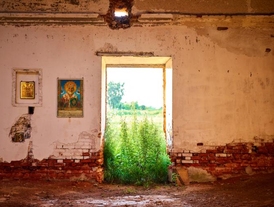Gagino
Breathtaking nature with oak forests, the meandering River Pyana, and a real expanse for fishing enthusiasts, the birthplace of Lenin's grandfather, and the «baronial» lands — there are many interesting things to see in the Gagino district.It is here that some of the most popular and beautiful estates in the Nizhny Novgorod region are located. Those which belonged to the Pashkov nobles and the French Baron Jomini, are a mere ten kilometers from each other. The journey from Nizhny Novgorod to the Gagino district is not the shortest: almost three hours on the road, but well worth it for all that you will see!
A FEW FACTS
WHAT TO DO IN THE CITY
01
Visit the stone-cutting factory
The Buturlino district is located on the border with the Gagino district. We will begin our journey from there, or more precisely from the village of Bornukovo. The Bornukovskaya Cave stone-cutting factory is located there, a place where unique handmade stone sculptures are created. Andrigite, or «Bornuk marble», has been mined since the XVIII century. Today, only a few people in the Nizhny Novgorod region still retain the skill of artistic stone working. The company organizes excursions, so that you can see all the stages of how the sculptures are created and cast your gaze over the most interesting exhibits in the museum. Be sure to buy a souvenir: all these charming sculptures with bears, hares, owls and other animals are sold here at a very reasonable price!
02
Admire the architecture of the Church of the Resurrection
It is believed that the emergence of the village of Yurievo, located on the banks of the River Pyana, is connected with the campaign of Ivan the Terrible against the Kazan Khanate at the end of the XVI century. In the 1820s, the owner of the village prince Alexander Golitsyn built the stone church of the Resurrection of the Living there. The design of the church was developed by Mikhail Korinthsky, one of the finest Volga architects of the XIX century. The temple has not been preserved in its original form, but you can still admire its wonderful architecture, with its rotunda and classically styled pilasters.
03
Visit the Pashkov family estate
In the village of Vetoshkino, in the grounds of an ancient natural park, surrounded by centuries-old oak trees, stands the ruined manor of the Pashkov noble family. It was built in the 1860s in the architectural tradition of European Romanticism. Many years ago, this was a real manor estate, which included a manor house with more than a hundred halls, a servants' wing, a winter garden, wine cellars, a stud farm, and other buildings. All this luxury could not be preserved, but the estate lives on. Today you can stay at the guest house, and take an excursion to visit the museum, see the Grafsky pond, learn about the history of this place, and take a stroll through the English park.
04
Feast your eyes at the estate of Baron Jomini
The construction of this estate, which had been granted to Baron Antoine-Henri Jomini by Emperor Alexander I, began in 1813. The first thing that every guest of the estate sees is an «ethnic village», where there is an apiary, a flourmill, a medicine woman's house, and other fairytale characters. The manor house itself, which has survived through to the present day, with its lavishly decorated balcony, is located on a hill, offering a magnificent view of the tree-lined alley. Today, a small lake with bridges, and a garden filled with vineyards have also been restored here. As part of the tour, guests are invited to take a stroll through the park’s alleys, to taste some mead and take their rest in the gazebos, all in the finest traditions of noble recreation.
05
Learn about the Gagino district’s past in the Museum of Local History
This museum has traditional permanent exhibitions that will help you to find out more about the history of the Gagino district. Here you will see archaeological finds, the costumes and jewelry of the Erzya people, artefacts of the lives of both the peasants and the local merchants, as well as unique exhibits belonging to the Pashkov nobles, such as a logbook, or a desk that is over two centuries old.
06
Marvel at the church of the Vladimir Icon of the Mother of God
Superstition is connected with the history of this church, the construction of which began in the 1820s: according to legend, its builders were doomed to perish as soon as all three of the temple’s thrones (and there were indeed three of them) were consecrated. In the event, the prediction did not come true, but the final finishing touches to the temple were completed only in the 1860s. Today, much of this church, which was constructed according to the Russian-Byzantine style, has fallen into ruin, but its main space, with its arched vaults, the dome space, and part of the bell tower, have been preserved. Most amazing of all is its interior decoration, where instead of an altar and thrones, you can see only icons and holy images hung on the walls by locals.




















